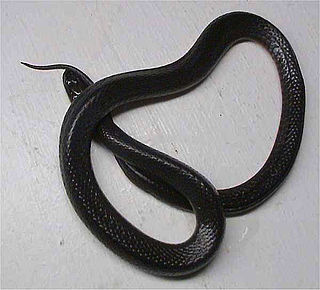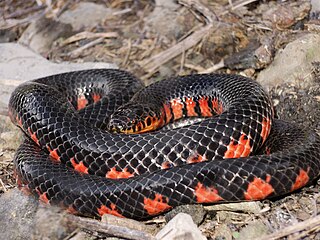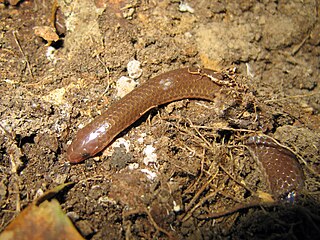
The hellbender, also known as the hellbender salamander, is a species of aquatic giant salamander endemic to the eastern and central United States. It is the largest salamander in North America. A member of the family Cryptobranchidae, the hellbender is the only extant member of the genus Cryptobranchus. Other closely related salamanders in the same family are in the genus Andrias, which contains the Japanese and Chinese giant salamanders. The hellbender, which is much larger than all other salamanders in its geographic range, employs an unusual means of respiration, and fills a particular niche—both as a predator and prey—in its ecosystem, which either it or its ancestors have occupied for around 65 million years. The species is listed as Vulnerable on the IUCN Red List of Threatened Species due to the impacts of disease and widespread habitat loss and degradation throughout much of its range.

The scarlet kingsnake or scarlet milk snake is a species of kingsnake found in the southeastern and eastern portions of the United States. Like all kingsnakes, they are nonvenomous. They are found in pine flatwoods, hydric hammocks, pine savannas, mesic pine-oak forests, prairies, cultivated fields, and a variety of suburban habitats; not unusually, people find scarlet kingsnakes in their swimming pools, especially during the spring. Until recently, and for much of the 20th century, scarlet kingsnakes were considered a subspecies of the milk snake; however, Pyron and Bubrink demonstrated the phylogenetic distinction of this species and its closer relationship to the mountain kingsnakes of the southwestern United States. These largely fossorial snakes are the smallest of all the species within the genus Lampropeltis, usually ranging from 40 to 50 cm at maturity. The maximum recorded length is in Jonesboro, AR 76.2 cm (30.0 in). Hatchlings range in size from 8 to 18 cm .

The black swamp snake is a species of snake in the subfamily Natricinae of the family Colubridae. The species is endemic to the southeastern United States. There are three subspecies, including the nominotypical subspecies.

Carphophis is a genus of small colubrid snakes endemic to the United States. The genus consists of two species, one of which has two subspecies.

Arizona elegans arenicola, commonly known as the Texas glossy snake, is a subspecies of nonvenomous colubrid snake endemic to North America.

Nerodia clarkii, commonly known as the salt marsh snake, is a species of semi-aquatic, nonvenomous, colubrid snake found in the southeastern United States. Their range extends along the brackish salt marshes of the Gulf of Mexico and the Atlantic Coast from Texas to Florida, with an additional population in northern Cuba. Different subspecies of this snake are primarily identified via color patterns on each snake's belly, or anterior.

The mud snake is a species of nonvenomous, semiaquatic, colubrid snake endemic to the southeastern United States.

Arizona elegans philipi, commonly known as the Painted Desert glossy snake, is a subspecies of glossy snakes, a nonvenomous colubrid endemic to North America.

Thamnophis saurita saurita, the eastern ribbon snake or common ribbon snake, is one of four subspecies of the ribbon snake found in the southeastern United States.

Pituophis melanoleucus, commonly known as the eastern pine snake, is a species of nonvenomous snake in the family Colubridae. The species is endemic to the southeastern United States. Three subspecies are currently recognized as being valid.

The crayfish snake, also known commonly as the glossy crayfish snake, the glossy swampsnake, the glossy water snake, and the striped water snake, is a species of semiaquatic snake in the subfamily Natricinae of the family Colubridae. The species is endemic to the southeastern United States, and preys mainly on crayfish.

The Gulf crayfish snake is a subspecies of nonvenomous snake endemic to the southeastern United States.
The striped crayfish snake is a species of semiaquatic North American snake in the family Colubridae. The species derives its common name from its principal prey, crayfish. This snake is also called Allen's snake, the striped swamp snake, the striped swampsnake, or simply the swamp snake. It is endemic to peninsular Florida. Although rarely seen due to its secretive behavior, it can be found in large numbers in wet areas, with densities approaching 1,300 snakes per hectare.

The copperbelly water snake or copperbelly is a subspecies of nonvenomous colubrid snake endemic to the Central United States.

The eastern glass lizard is a species of legless lizard in the family Anguidae and the longest and heaviest species of glass lizards in he genus Ophisaurus, endemic to the Southeastern United States. The streamlined, legless species is often confused with snakes. Glass lizards differ from snakes as they possess a moveable eyelid and an external ear opening as well as a lateral groove that separates the different types of scales on the animal, all three of these features are absent in snakes. Snakes also have flexible jaws while lizards do not. Ventralis comes from the Latin "venter" meaning belly; this is in reference to the snake-like movement.

The Florida crowned snake is a species of colubrid snake found in Florida and Georgia. It is a small, slender, non-venomous snake that is rarely seen. The species is commonly found in north and central Florida, and is most often associated with sandy habitats.

The eastern worm snake is a subspecies of the worm snake, Carphophis amoenus, a nonvenomous colubrid endemic to the Eastern Woodlands region of North America. The species' range extends from southwest Massachusetts, south to southern Alabama, west to Louisiana and north to Illinois. This species is common in the ecotone between woodlands and wetlands. It may also be found in grasslands adjacent to woodlands. Though this snake can be abundant in parts of its range, it is rarely seen because of its fossorial lifestyle. When not underground, C. a. amoenus resides mostly under rocks, logs and leaf litter, or burrowed within rotting woody debris. This snake is perfectly safe to pick up, as it cannot bite, but may produce a foul-smelling excretion.

Liodytes is a genus of snakes in the subfamily Natricinae of the family Colubridae. The genus contains three species.














